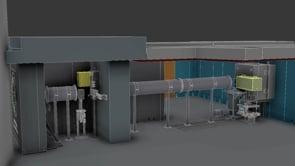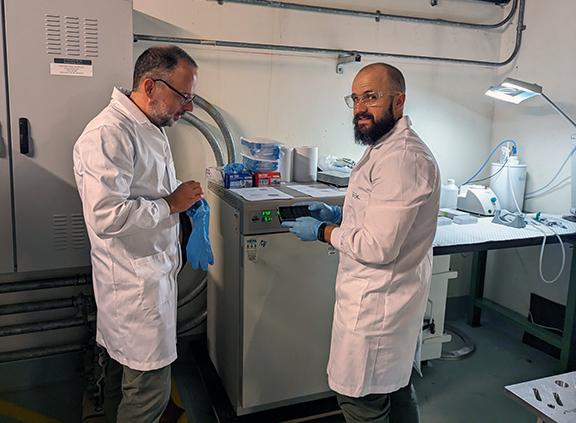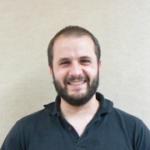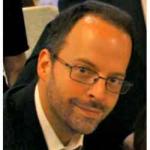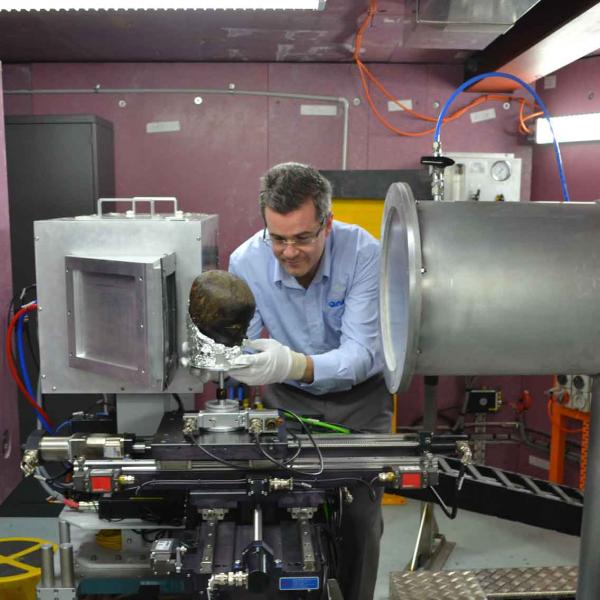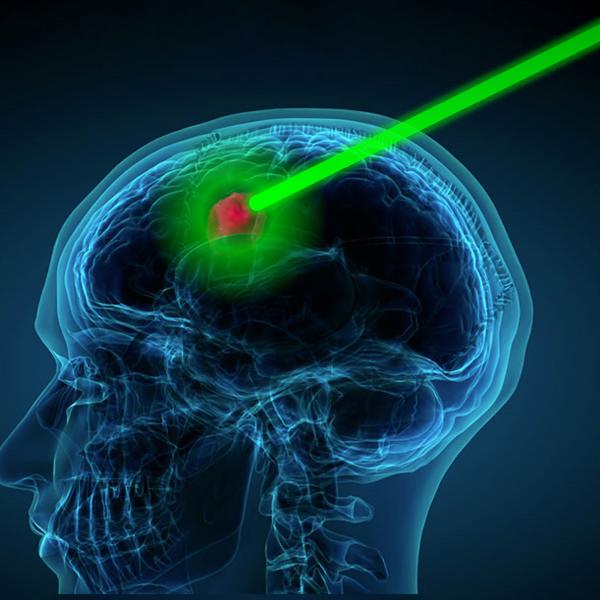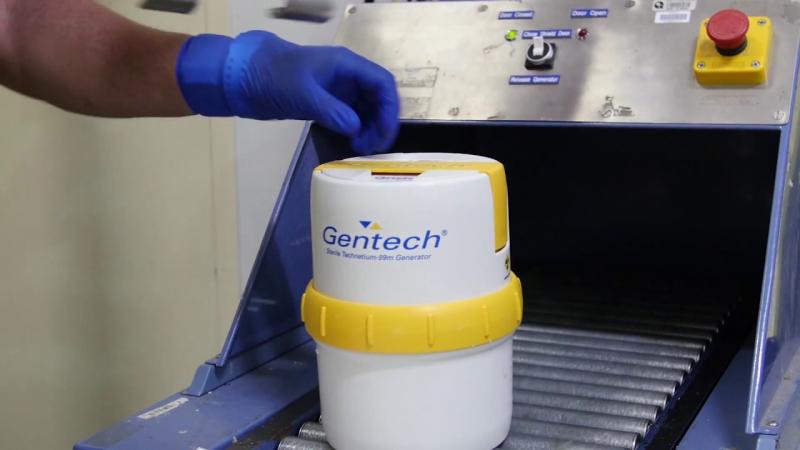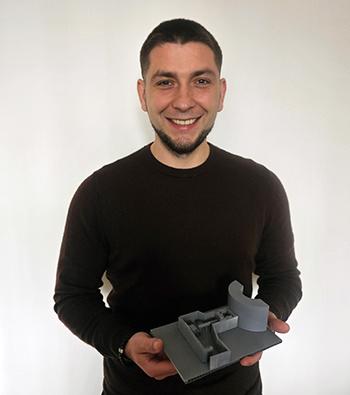
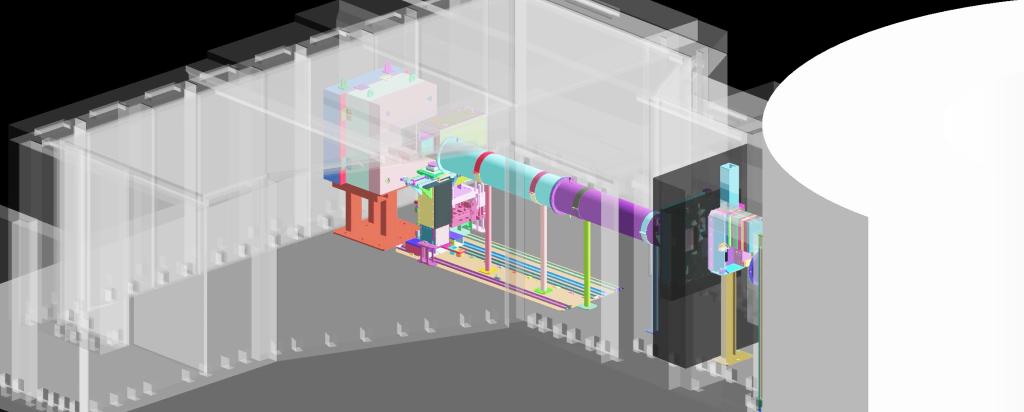
Published on the 25th July 2025 by ANSTO Staff
One of ANSTO’s advanced imaging instruments Dingo now delivers a rare fusion of simulation and radiobiology, becoming a launchpad for an innovative neutron therapy innovation.
This unique scientific capability comprises a single research platform for high-fidelity simulation, real-time dosimetry, and biological response data - all from a neutron beam instrument.
Caption: This sequence shows the full-stack research capability underpinning Australia’s neutron capture therapy research: (1) Beamline schematic showing the Dingo thermal neutron pathway, including the sapphire filter and major components modelled in simulation; (2) Three-dimensional Geant4 rendering of the validated beamline model, used to predict neutron spectra and inform experimental planning; (3) Cellular response to boron-10 neutron capture in human glioma cells, visualised through immunocytochemical staining of DNA damage (green) within nuclei (blue), with cytoskeletal structures highlighted in red. Two new papers published in Scientific Reports report how ANSTO researchers have adapted neutron tomography into a fully integrated testbed for neutron capture therapy research. The platform allows scientists to model conditions, plan experiments, and irradiate live cells, all within a validated, operational system.
The OPAL multi-purpose research reactor delivers neutrons to the instrument at the Australian Centre for Neutron Scattering.
Simulation that informs real biology
At the core of this platform is a validated Monte Carlo model of the Dingo instrument, incorporating crystalline filter physics, advanced spectral unfolding, and a user-friendly graphical interface. Researchers can now predict neutron spectra - both in and out of beam -and configure experimental setups with precision, before entering the lab.

“The validated model gives us a level of confidence we didn’t have before,” said Dr Klaudiusz Jakubowski (pictured left), lead author of the simulation study. “It allows teams to simulate neutron fields with high fidelity and plan experiments precisely - before they touch the beamline.”
This digital twin forms the planning backbone for a new in vitro irradiation capability, now used to investigate the biological effects of neutron capture at the cellular level.
Targeted therapy, measured impact
Using the model to define neutron beam conditions, the team successfully delivered biologically meaningful thermal neutron doses to human glioblastoma cells. DNA damage was assessed using both flow cytometry and immunocytochemistry, confirming the effects of boron neutron capture in live cells. The irradiation system was developed without impacting the configuration for existing users, a key requirement for any modification to Dingo’s multi-user operations.
“We have shown that neutron radiobiology can be done at scale, without dedicated facilities,” said Mr Nicholas Howell, lead author of the biological study . “It is robust, reproducible, and designed to slot into existing infrastructure. That’s what makes it sustainable.”
This approach is now being used to evaluate novel neutron capture agents for Boron Neutron Capture Therapy (BNCT) and Neutron Capture Enhanced Particle Therapy (NCEPT), a hybrid modality that harnesses neutron fields generated during proton and ion beam treatments.
“Dingo was never designed for this kind of work, which makes it all the more impressive that the team achieved biological irradiation with the existing instrument configuration,” said Dr Joseph Bevitt, instrument scientist at the Australian Centre for Neutron Scattering. “It is a great example of what’s possible when you bring simulation, beamline expertise, and experimental ambition together.”
Training infrastructure, not just test infrastructure
The platform is also playing a foundational role in training the next generation of scientists. PhD students, interns, and early-career researchers are directly involved in simulation, irradiation planning, and post-experiment analysis, gaining hands-on experience in a real-world translational research environment.
“This is a clear example of how a neutron beam instrument can be configured unique scientific questions incorporating modelling, dosimetry, and biological response all in one pipeline,” said Dr Bevitt. “As a result of this work it is now a capability that is accessible to the broader research community.”
A national asset reimagined
“These kinds of validated facilities matter not just for research but for national capability,” said Dr Mitra Safavi-Naeini, who leads the broader NCEPT program. “In other countries, beamlines like this are used by industry to test electronics, develop pharmaceuticals, and study radiation damage in materials. We have now shown that Australia can do the same and do it smart.”
Further enhancements to the Dingo instrument are underway, including automation of dosimetry workflows, temperature-controlled sample environments, and expanded support for pharmaceutical screening.
This work demonstrates what is possible when simulation, experimental physics, and biology are designed to work together, and why full-stack research capability is critical for Australia’s future in advanced radiation science.
Others at ANSTO who contributed to these publications included Chris Dobie, Scott Olsen, Ulf Garbe, Attila Stopic, and Raya Jarrah.
